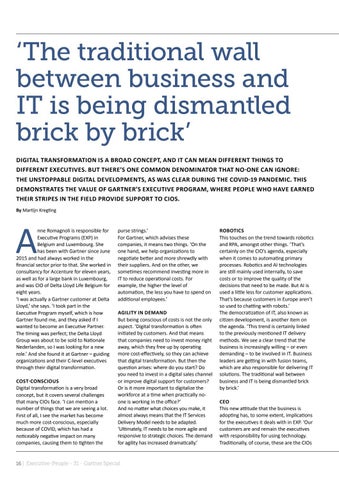‘The traditional wall between business and IT is being dismantled brick by brick’ DIGITAL TRANSFORMATION IS A BROAD CONCEPT, AND IT CAN MEAN DIFFERENT THINGS TO DIFFERENT EXECUTIVES. BUT THERE’S ONE COMMON DENOMINATOR THAT NO-ONE CAN IGNORE: THE UNSTOPPABLE DIGITAL DEVELOPMENTS, AS WAS CLEAR DURING THE COVID-19 PANDEMIC. THIS DEMONSTRATES THE VALUE OF GARTNER’S EXECUTIVE PROGRAM, WHERE PEOPLE WHO HAVE EARNED THEIR STRIPES IN THE FIELD PROVIDE SUPPORT TO CIOS. By Martijn Kregting
A
nne Romagnoli is responsible for Executive Programs (EXP) in Belgium and Luxembourg. She has been with Gartner since June 2015 and had always worked in the financial sector prior to that. She worked in consultancy for Accenture for eleven years, as well as for a large bank in Luxembourg, and was CIO of Delta Lloyd Life Belgium for eight years. ‘I was actually a Gartner customer at Delta Lloyd,’ she says. ‘I took part in the Executive Program myself, which is how Gartner found me, and they asked if I wanted to become an Executive Partner. The timing was perfect; the Delta Lloyd Group was about to be sold to Nationale Nederlanden, so I was looking for a new role.’ And she found it at Gartner – guiding organizations and their C-level executives through their digital transformation. COST-CONSCIOUS Digital transformation is a very broad concept, but it covers several challenges that many CIOs face. ‘I can mention a number of things that we are seeing a lot. First of all, I see the market has become much more cost-conscious, especially because of COVID, which has had a noticeably negative impact on many companies, causing them to tighten the
purse strings.’ For Gartner, which advises these companies, it means two things. ‘On the one hand, we help organizations to negotiate better and more shrewdly with their suppliers. And on the other, we sometimes recommend investing more in IT to reduce operational costs. For example, the higher the level of automation, the less you have to spend on additional employees.’ AGILITY IN DEMAND But being conscious of costs is not the only aspect. ‘Digital transformation is often initiated by customers. And that means that companies need to invest money right away, which they free up by operating more cost-effectively, so they can achieve that digital transformation. But then the question arises: where do you start? Do you need to invest in a digital sales channel or improve digital support for customers? Or is it more important to digitalize the workforce at a time when practically noone is working in the office?’ And no matter what choices you make, it almost always means that the IT Services Delivery Model needs to be adapted. ‘Ultimately, IT needs to be more agile and responsive to strategic choices. The demand for agility has increased dramatically.’
16 | Executive-People - 31 - Gartner Special
ROBOTICS This touches on the trend towards robotics and RPA, amongst other things. ‘That’s certainly on the CIO’s agenda, especially when it comes to automating primary processes. Robotics and AI technologies are still mainly used internally, to save costs or to improve the quality of the decisions that need to be made. But AI is used a little less for customer applications. That’s because customers in Europe aren’t so used to chatting with robots.’ The democratization of IT, also known as citizen development, is another item on the agenda. ‘This trend is certainly linked to the previously mentioned IT delivery methods. We see a clear trend that the business is increasingly willing – or even demanding – to be involved in IT. Business leaders are getting in with fusion teams, which are also responsible for delivering IT solutions. The traditional wall between business and IT is being dismantled brick by brick.’ CEO This new attitude that the business is adopting has, to some extent, implications for the executives it deals with in EXP. ‘Our customers are and remain the executives with responsibility for using technology. Traditionally, of course, these are the CIOs
Executive-People - 31 - Gartner Special






